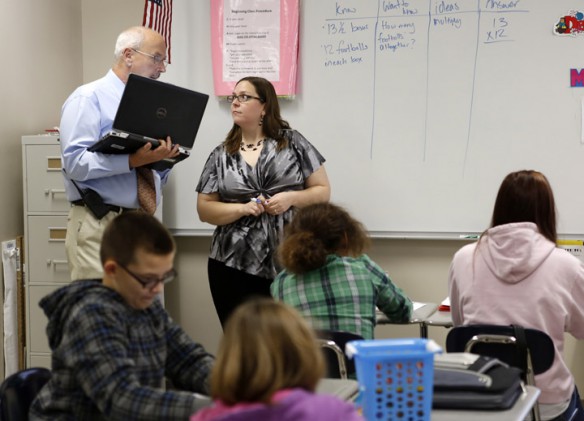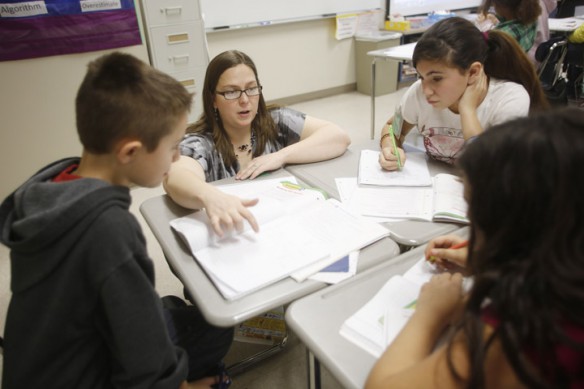
Principal Curt Bieger talks briefly with Mandy Young before she starts her 6th-grade mathematics class at Gallatin County Middle School. Bieger was observing her class as part of the Professional Growth and Effectiveness System.
Photo by Amy Wallot, Dec. 3, 2012
- The Kentucky Department of Education, along with several partners and more than 50 school districts, is in the third year of a four-year plan to develop the Professional Growth and Effectiveness System (PGES). Schools statewide will pilot the new system in the 2013-14 school year, with full implementation scheduled for 2014-15. This is the second in a series of stories that will examine different aspects of the proposed system.
By Matthew Tungate
matthew.tungate@education.ky.gov
Being observed by the principal traditionally is a stressful part of a teacher’s evaluation, according to Mandy Young, a 6th-grade mathematics teacher in her fifth year at Gallatin County Middle School. But as a participant in the field testing for Kentucky’s proposed Professional Growth and Effectiveness System (PGES), Young got a “dress rehearsal” by being observed first by colleague Kim Jones, a teacher and mathematics instructional coach in her 26th year.
“My job isn’t based on her evaluation, so I felt comfortable to try different things with her in there, plus she could give me feedback and I didn’t feel that my job was on the line because of it,” Young said.
Young even knew what Jones was looking for because they had discussed items on the younger teacher’s professional growth plan prior to the observation. Afterward, they discussed what Jones observed. Young said she can use PD 360 or talk with her professional learning community about any areas for improvement.
Observation is one measure of teacher effectiveness in the PGES. Peer observers and principals or other supervisors are trained to document evidence during their observations based on two domains of the Kentucky Framework for Teaching: classroom environment and instruction. Afterward, they discuss evidence from the observation with the teacher based on the indicators and the criteria from the Framework for Teaching rubric.
Cathy White, manager of the Teacher and Leader Effectiveness Branch of the Kentucky Department of Education (KDE), said the peer observer is not evaluating the observed teacher. Peer observers are there to tell teachers what they saw and to ask questions that get the teachers thinking.
“Through collegial conversations, you engage teachers in a non-threatening way in discussion of their practice that offers them the potential to grow in ways that they’ve never had an opportunity to grow before. It is professional growth that can have an impact on student learning,” she said.
“You now have professional dialogue happening where teachers are analyzing their own practice and their craft,” White said. “Not only is the teacher who is being observed having the opportunity to reflect and grow but the peer observer has the same opportunity as well.”
Carolyn Noe, a 2nd-grade teacher in her 31st year in education, is a peer observer at Paint Lick Elementary School (Garrard County) and thinks peer reviews are a great idea. However, taking 20 minutes to observe every teacher in a school will be very time consuming, she said.
“We’re very protective of our instructional time,” she said. “When you start pulling someone out even for a mini-observation, there are a few questions that need to be addressed: Who’s going to cover the observer’s classroom? Is it someone who can continue the lesson you have already started or are getting ready to be begin?”
Not every teacher will be a peer observer. It will be up to schools and districts to decide who has the knowledge, skill and rapport to be peer observers, White said.
To train the peer observers for the field test, KDE offered two days of training for observed teachers, three days of training for peer observers and four days for principals, White said. However, participants in the field test said they wanted the training more streamlined, multiple ways to access the information and wanted it available around the clock.
So in the future, KDE will do face-to-face sessions and live online interactive sessions; online voice-over PowerPoints and handouts are available at the KDE website, she said
Principals must be certified to do observations
Principals will observe teachers using the same criteria as peer observers. Additional training will help principals identify effective teaching and where there may be opportunities for professional learning.
Having all supervising observers receive certification ensures equity across the state with valid and reliable observations, White said.
“We can say, ‘Our principals know what good instruction looks like,’” she said.
The use of a common framework will ensure consistent understanding across the state on the criteria, practices, and language related to the characteristics of highly effective teaching and learning, White said.
Gallatin County Superintendent Dot Perkins received her certification because she felt she should be responsible for the information in the modules and needed to know what principals were responsible for doing to fairly evaluate them. She said it takes 20-30 hours to go through the training and another 12 hours for the tests.
“You can’t multi-task while you’re doing the training,” she said. “You have to be focused.”
Perkins said the modules helped identify her personal bias about what she thought good teaching looks like compared to what it really looks like, and it helped give her a common vocabulary with her principals.
“It made my principals better just by going through the training,” she said.
Curt Bieger, principal of Gallatin County Middle School, agreed. He said watching the videos showed him what good teaching looks like, and he has even gone back since passing his certification to watch a couple of the videos again.
“Nobody had ever explained the standards the way they did in that training,” he said. “As a supervisor of instruction, it opened my eyes as to what things should look like.”
Perkins said the observation protocols not only help principals recognize what is working well and what isn’t, but gives them specific ways to help teachers improve on the behaviors and practices identified in the Framework for Teaching.
“Looking at the rubric and standards, they actually have the tools in their toolbox now to say, ‘Here is something you could do to make this three a four or this two a three,’” she said.
The current evaluation system, which Perkins said is “nothing more than compliance – meets standard or doesn’t meet standard,” doesn’t allow for much growth. PGES is based on continuous improvement and uses continuum ranging from ineffective, developing, accomplished to exemplary.
“With the new system, a teacher is going to see exactly where they line up,” Perkins said.

Mandy Young helps Dylan Wyrick, Autumn Gaylor and Adriana Cruz with fractions during her 6th-grade mathematics class at Gallatin County Middle School.
Photo by Amy Wallot, Dec. 3, 2012
Schools and districts will use the data from this measure and the other measures to inform a teacher’s professional learning needs for ongoing improvement.
There are still questions about the observations, such as how many principal observations need to be for an entire class period and how many can be conducted in 20-30 minutes; does a teacher have to receive a principal observation every year; and how much latitude will schools and districts have to implement the system, White said.
The current field test (2012-13 school year) is providing an opportunity for the state to learn about exemplary models and practices to consider for future implementation.
Everything still comes down to one key point, Perkins said – whether a teacher’s professional practice improves student achievement.
“If we’re going through this new evaluation system and it doesn’t translate to getting down to the student desktop and creating better learning opportunities for them, then it’s a waste of time, so we are working very hard to make sure it impacts student learning,” she said.
That’s why the PGES is a true coaching model, she said.
“It is designed to help professional educators improve, and I believe 99.99 percent of all teachers want to be the best they can be and they just don’t know how,” Perkins said. “They don’t know what they don’t know.”
MORE INFO …
Cathy White, cathy.white@education.ky.gov, (502) 564-1479, ext. 4019


Leave A Comment